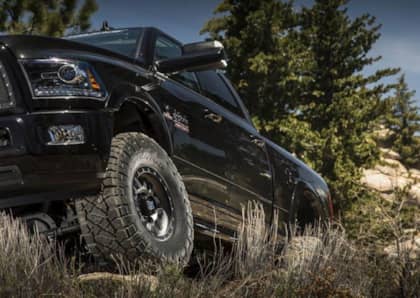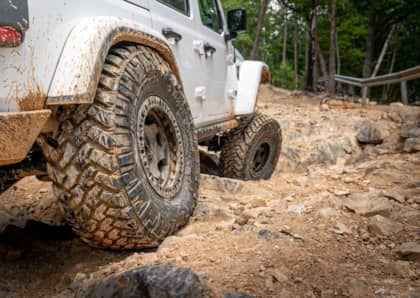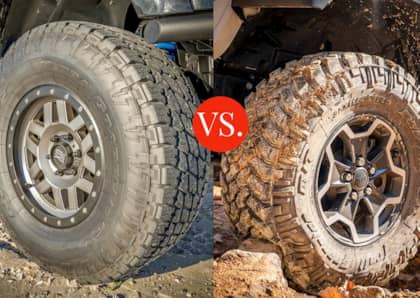What You Need to Know If You Own All-Terrain or Mud-Terrain Tires
If people were reincarnated as objects, telemarketers would come back as off-road tires. The life of an all-terrain or mud tire isn't easy. You bear a ton of weight over the harshest driving conditions imaginable until you die. That's it; no birthday parties, no Christmas presents. Just you, a heap of hard-charging metal, and some yahoo in the cockpit who insists on running you roughshod. Luckily, we don't come back in tire form. Instead, Companies like Nitto make better and better all-terrain and mud tires using the latest R&D. Although tires like the Ridge Grappler and Mud Grappler can handle a lot of punishment, the better care you give them, the more life you get out of them. Let's delve into some of the things you can do to get the most out of those tires.
Immortal Kombat
Tires eventually lose tread and get replaced. It's inevitable. What isn't set in stone is how long they last. Part of that comes from how well made they are, but you can maximize their lifespan with the right kind of care.

Selecting the right off-road tire is the first step. Sizes and tread patterns suitable to your driving are vital but so is the load range. That's usually a letter printed on the tire's sidewall. You don't want a tire designed for a lighter vehicle installed on a heavy truck that tows a trailer all the time. Airing down is also important for off-road running because doing so increases the traction patch it makes on the ground. Decreased tire pressure reduces slip in gravel and other terrain because of the increased traction, thereby reducing the rate of wear on the tread. If you have a full-size spare tire, rotating it into the mix helps too. Find out more on maximizing tire life here.
Clean Getaway
All-terrain and mud tires pack a higher profile than their low-profile street cousins. That means more rubber to clean. Not only that, they have a rougher life and the wrong cleaner can shorten their life in much the same way gargling Lysol would shorten yours. Yes, you'd kill all the germs but the cost is pretty steep.

The big question here is: are dedicated wheel and tire cleaners worth buying or do household cleaners work just as well? Yes and no. Bleach, dishwashing soap, and bathroom cleaner will remove mud and restore the black finish on your tires with varying degrees of success. The same can't necessarily be said of the wax-and-wash car cleaners used on street cars. There are plenty of wheel-and-tire cleaners on the market, though. What you have to watch out for are how cleaners affect your wheel finishes. You can get more insight from our tire cleaner test as well.
Check Yourself Before You Wreck Yourself
Regular tire inspection isn't a bad plan, either. Off-roading is a seasonal pastime for many of us and the perfect times to check your tires for damage is at the end or beginning of the season.

Know that cleaning we were just talking about? Not only does it look good, it also helps determine how well your tires are holding up under all of that mud and grime. So once you've finally gotten around to cleaning your all-terrain or mud tires at season's end, you're more likely to find things like sidewall cuts that can kill a tire over time. Tread depth is another thing to look at; while road tires are considered done once depth reaches 2/32-inch, all-terrain and mud tires need much more than that to be effective in mud or over rocks. You may also notice uneven wear on your tires. That means it's either time to rotate them, you have a suspension issue, or both. Find out more things to consider here.
Under Pressure
Airing down your tires bears more discussion in detail. There's a little more to it than just whooshing some air out, recapping the valve stem, and hitting the trail.

I mean, you can just use a pen or a paper clip to vent air from the valve stems but that's about as fast and fun as watching paint dry. In Florida. In the humid summer. A valve core remover and a low-pressure tire gauge work much better. Plus, the gauge lets you know where you stand PSI-wise. That's important because setting PSI to the right numbers for your vehicle weight, tire diameter, and wheel size makes a difference. Plus, you don't want to go below 10 PSI when running non-beadlock wheels. Beadlock wheels lock the tire to the wheel which is what allows you to drop PSI into single digits. While airing down is free and easy, airing back up is a little more involved. You can't just wrap your mouth around all four valve stems and huff and puff them back up to full pressure. Having a good compressor is vital. We have more details on airing down for you here.
Damage Control
Mr Miyagi summed this up in The Karate Kid by telling Daniel that the best way to avoid a punch is not be where it lands. Being prepared beforehand and anticipating issues ahead of time avoids damage before it happens, thus extending the life of your tires and the rest of your vehicle, too.

In the case of tires, having the right tools on hand before you head out is a great plan. Make sure you have a jack, tire iron, and the above-mentioned tools for setting pressure beforehand. It's also good to have a Plan B (or even C and D) in anticipation of changing weather conditions, closed routes, and other common variables so you don't have to cut the trip short. Recognizing when a trail is too difficult for your rig also avoids a lot of problems. Scoping the route helps with that. Get more tips on avoiding damage off-road.
Check out our off-road survival checklist for a comprehensive of list of must-haves.











